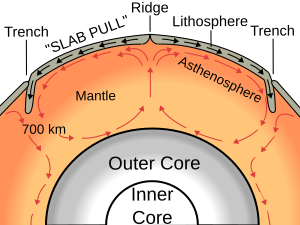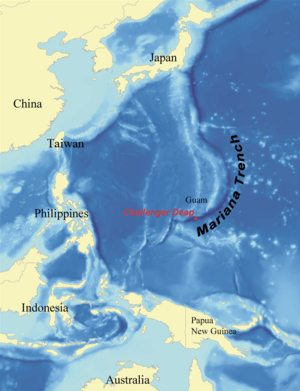Marine geology facts for kids
Marine geology is the study of the ocean floor and what it's made of. It's also called geological oceanography. Scientists who study marine geology look at the history and structure of the seabed. They use tools from geophysics, geochemistry, sedimentology, and paleontology. This helps them understand the ocean floor and coastal areas.
Marine geology is closely linked to geophysics (the study of Earth's physical processes) and physical oceanography (the study of ocean movements). After World War II, marine geology was very important. It gave strong proof for sea floor spreading and plate tectonics. These ideas explain how Earth's large plates move. The deep ocean floor is still a mysterious place. Mapping it helps with military goals (like submarines) and economic goals (like finding petroleum and metals).
Contents
Exploring the Ocean Floor
The Pacific Ring of Fire is an area around the Pacific Ocean. It has many active volcanoes and earthquakes. This area can cause dangerous earthquakes, tsunamis, and volcanic eruptions. To create early warning systems for these events, we need to know more about the marine geology of coasts and island arcs.
Scientists also study how sediment builds up in shallow and deep parts of the ocean. They look at how calcium carbonate forms and dissolves. This research is very important for understanding global climate change.
Amazing Discoveries in the Deep Sea
Scientists have found amazing things in the deep ocean. They discovered volcanoes along mid-ocean rift zones. These are cracks in the ocean floor where new crust forms. They also found hydrothermal vents. These are like hot springs on the ocean floor. The first ones were found in the Red Sea. Later, more were found along the East Pacific Rise and the Mid-Atlantic Ridge.
These vents are still important areas for marine geology research. Scientists found special organisms called extremophiles living near these hot vents. These creatures can survive in very harsh conditions. Their discovery changed what we thought was possible for life on Earth. It even gave us new ideas about how life might have started.
Deepest Parts of the Ocean
Oceanic trenches are very long and narrow dips in the sea floor. They are the deepest parts of the ocean. They can stretch for thousands of kilometers.
The Mariana Trench is the deepest known trench. It is also the deepest place in Earth's crust. It is a subduction zone. This means the Pacific Plate is sliding underneath the Mariana Plate there. The bottom of the Mariana Trench is deeper below sea level than Mount Everest is above sea level. It's an incredible place!
See also
 In Spanish: Geología marina para niños
In Spanish: Geología marina para niños



